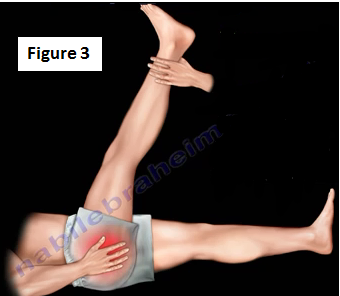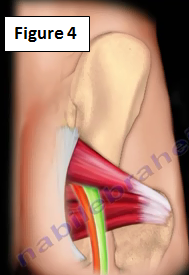The sciatic nerve is compressed by the piriformis muscle in the buttock (Figure 1). Piriformis syndrome may be associated with lower lumbar radiculopathy similar to spine pathology. Some patients may have spine surgery without improvement.
Symptoms
There is limited information about symptoms associated with piriformis syndrome. Occasionally symptoms will develop from blunt trauma to the buttocks. Localized buttock pain is increased by sitting or driving (Figure 2). Pain may also increase by bicycling or running in young individuals. Radicular symptoms with pain and paresthesia may also occur, however it is not common. Pain may be present when palpating directly deep into the area of the greater sciatic notch.
Provocative Test
The Lasegue's Maneuver is used to reproduce the pain by the hip being flexed to 90° and the knee extended (Figure 3). The sciatic nerve is compressed by the piriformis muscle, fibrous bands, or by vascular anomalies. Be aware of possible anatomical variation of the sciatic nerve.
Variations
There are four types of anatomical variations of the sciatic nerve. The sciatic nerve is composed of the tibial (red) and peroneal (green divisions which are usually bound together but sometimes may divide as they pass the piriformis muscle (Figure 4).
Relation of the sciatic nerve to the piriformis muscle:
1. Normal relationship with the sciatic nerve passing beneath the piriformis muscle (Figure 5a).
2. Piriformis divided into two parts with the peroneal division of the sciatic nerve passing between the two parts of the piriformis muscle (Figure 5b).
3. Peroneal division of the sciatic nerve passes over the muscle and the tibial division passes beneath the undivided piriformis muscle (Figure 5c).
4. The entire nerve passes through the divided piriformis muscle (Figure 5d).
Diagnosis
A high index of suspicion is needed to diagnose piriformis syndrome. The patient's history and exam can also aid in the diagnosis process. EMG and bone scans are not very helpful. An MRI could show an enlarged piriformis, anomalies of the vessels, and compression of the nerve. A diagnostic injection may be helpful.
Consider the possibility of piriformis syndrome when treated trochanteric bursitis or patients with sciatica, especially after a failed spine surgery. Patients with sciatica will have pathology in the lumbar spine as shown on MRI such as disc herniation, lumbar stenosis, or degenerative changes. Patients with piriformis syndrome may not have symptoms or MRI findings related to the lower back. High index of suspicion is needed in patients with buttock or leg pain in the absence of lumbar pathology. This pain is increased while sitting with minimal or no back pain. Piriformis Syndrome is a hidden cause of sciatica.
Treatment
Treatment for piriformis often includes aquatic therapy and physiotherapy. Patients will also be given NSAID medication. Surgical release of the piriformis muscle and decompression of the sciatic nerve is the last resort.
For more information on the piriformis, follow the links:
https://www.youtube.com/watch?v=QzFng74fueY
https://www.youtube.com/watch?v=E53d0sEpcI8
For more information, visit my YouTube Channel:
https://www.youtube.com/user/nabilebraheim




